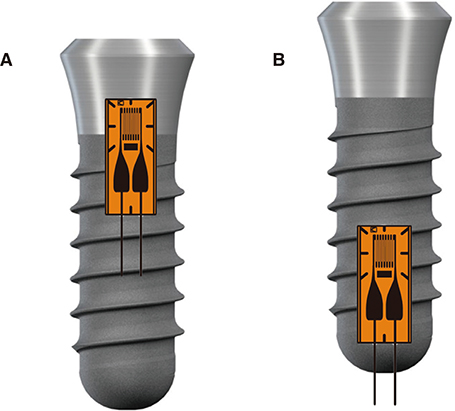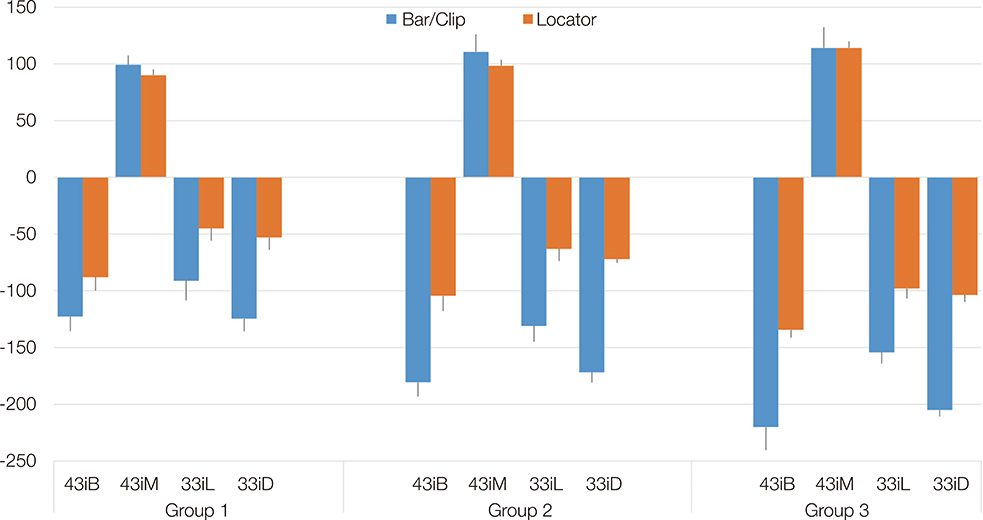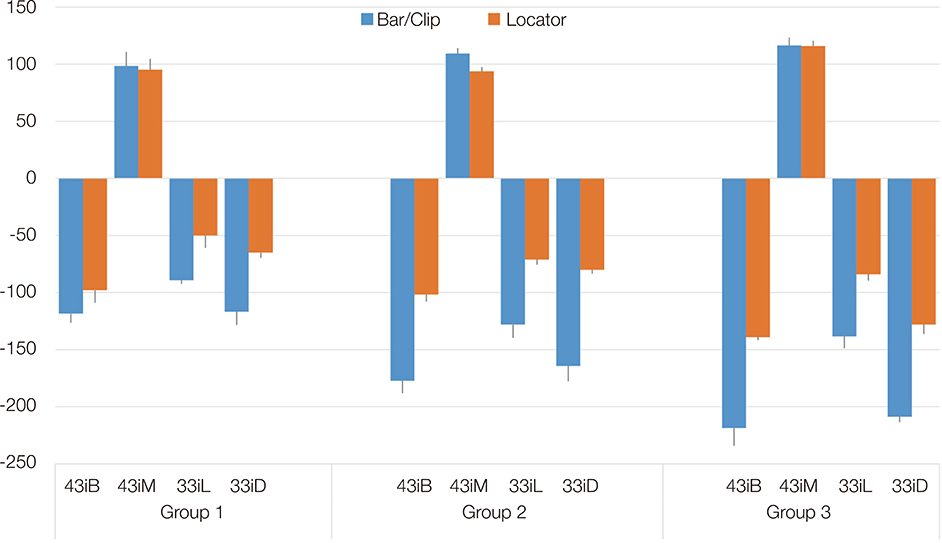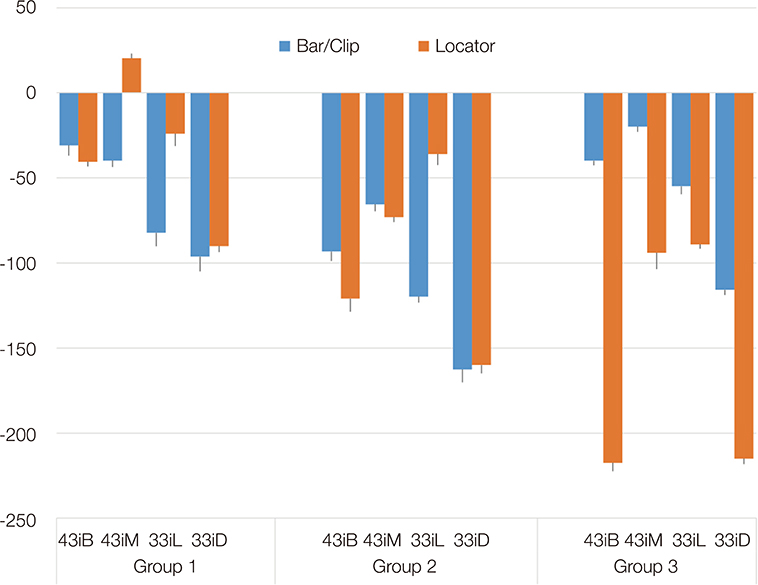J Adv Prosthodont.
2017 Jun;9(3):143-151. 10.4047/jap.2017.9.3.143.
Stress analysis of mandibular implant overdenture with locator and bar/clip attachment: Comparative study with differences in the denture base length
- Affiliations
-
- 1Private Practice, Seoul, Republic of Korea.
- 2Department of Prosthodontics, School of Dentistry, Kyung Hee University, Seoul, Republic of Korea. jp2703@khu.ac.kr
- KMID: 2382599
- DOI: http://doi.org/10.4047/jap.2017.9.3.143
Abstract
- PURPOSE
The design of the attachment must provide an optimum stress distribution around the implant. In this study, for implant overdentures with a bar/clip attachment or a locator attachment, the stress transmitted to the implant in accordance with the change in the denture base length and the vertical pressure was measured and analyzed.
MATERIALS AND METHODS
Test model was created with epoxy resin. The strain gauges made a tight contact with implant surfaces. A universal testing machine was used to exert a vertical pressure on the mandibular implant overdenture and the strain rate of the implants was measured.
RESULTS
Means and standard deviations of the maximum micro-deformation rates were determined. 1) Locator attachment: The implants on the working side generally showed higher strain than those on the non-working side. Tensile force was observed on the mesial surface of the implant on the working side, and the compressive force was applied to the buccal surface and on the surfaces of the implant on the non-working side. 2) Bar/clip attachment: The implants on the both non-working and working sides showed high strain; all surfaces except the mesial surface of the implant on the non-working side showed a compressive force.
CONCLUSION
To minimize the strain on implants in mandibular implant overdentures, the attachment of the implant should be carefully selected and the denture base should be extended as much as possible.
MeSH Terms
Figure
Reference
-
1. Doundoulakis JH, Eckert SE, Lindquist CC, Jeffcoat MK. The implant-supported overdenture as an alternative to the complete mandibular denture. J Am Dent Assoc. 2003; 134:1455–1458.2. Feine JS, Carlsson GE, Awad MA, Chehade A, Duncan WJ, Gizani S, Head T, Heydecke G, Lund JP, MacEntee M, Mericske-Stern R, Mojon P, Morais JA, Naert I, Payne AG, Penrod J, Stoker GT, Tawse-Smith A, Taylor TD, Thomason JM, Thomson WM, Wismeijer D. The McGill consensus statement on overdentures. Mandibular two-implant overdentures as first choice standard of care for edentulous patients. Gerodontology. 2002; 19:3–4.3. Burns DR. Mandibular implant overdenture treatment: consensus and controversy. J Prosthodont. 2000; 9:37–46.4. Jemt T, Carlsson L, Boss A, Jörneús L. In vivo load measurements on osseointegrated implants supporting fixed or removable prostheses: a comparative pilot study. Int J Oral Maxillofac Implants. 1991; 6:413–417.5. Naert I, De Clercq M, Theuniers G, Schepers E. Overdentures supported by osseointegrated fixtures for the edentulous mandible: a 2.5-year report. Int J Oral Maxillofac Implants. 1988; 3:191–196.6. Mericske-Stern R, Geering AH, Burgin WB, Graf H. Three-dimensional force measurements on mandibular implants supporting overdentures. Int J Oral Maxillofac Implants. 1992; 7:185–194.7. Setz J, Krämer A, Benzing U, Weber H. Complete dentures fixed on dental implants: chewing patterns and implant stress. Int J Oral Maxillofac Implants. 1989; 4:107–111.8. Rangert B, Jemt T, Jörneus L. Forces and moments on Branemark implants. Int J Oral Maxillofac Implants. 1989; 4:241–247.9. Tokuhisa M, Matsushita Y, Koyano K. In vitro study of a mandibular implant overdenture retained with ball, magnet, or bar attachments: comparison of load transfer and denture stability. Int J Prosthodont. 2003; 16:128–134.10. el-Sheikh AM, Hobkirk JA. Force transmission in bar-retained implant-stabilised mandibular over-dentures: an in-vitro study. Eur J Prosthodont Restor Dent. 2002; 10:173–178.11. Porter JA Jr, Petropoulos VC, Brunski JB. Comparison of load distribution for implant overdenture attachments. Int J Oral Maxillofac Implants. 2002; 17:651–662.12. Heckmann SM, Winter W, Meyer M, Weber HP, Wichmann MG. Overdenture attachment selection and the loading of implant and denture-bearing area. Part 1: In vivo verification of stereolithographic model. Clin Oral Implants Res. 2001; 12:617–623.13. Meijer HJ, Kuiper JH, Starmans FJ, Bosman F. Stress distribution around dental implants: influence of superstructure, length of implants, and height of mandible. J Prosthet Dent. 1992; 68:96–102.14. Rosa LB, Bataglion C, Siéssere S, Palinkas M, Mestriner W Jr, de Freitas O, de Rossi M, de Oliveira LF, Regalo SCH. Bite force and masticatory efficiency in individuals with different oral rehabilitations. Open J Stomatol. 2012; 2:21–26.15. Federick DR, Caputo AA. Effects of overdenture retention designs and implant orientations on load transfer characteristics. J Prosthet Dent. 1996; 76:624–632.16. Menicucci G, Lorenzetti M, Pera P, Preti G. Mandibular implant-retained overdenture: finite element analysis of two anchorage systems. Int J Oral Maxillofac Implants. 1998; 13:369–376.17. Meijer HJ, Starmans FJ, Steen WH, Bosman F. A three-dimensional, finite-element analysis of bone around dental implants in an edentulous human mandible. Arch Oral Biol. 1993; 38:491–496.18. Meijer HJ, Starmans FJ, Steen WH, Bosman F. A three-dimensional finite element study on two versus four implants in an edentulous mandible. Int J Prosthodont. 1994; 7:271–279.19. Menicucci G, Lorenzetti M, Pera P, Preti G. Mandibular implant-retained overdenture: a clinical trial of two anchorage systems. Int J Oral Maxillofac Implants. 1998; 13:851–856.20. Duyck J, Van Oosterwyck H, Vander Sloten J, De Cooman M, Puers R, Naert I. In vivo forces on oral implants supporting a mandibular overdenture: the influence of attachment system. Clin Oral Investig. 1999; 3:201–207.21. Sadowsky SJ, Caputo AA. Effect of anchorage systems and extension base contact on load transfer with mandibular implant-retained overdentures. J Prosthet Dent. 2000; 84:327–334.22. Trakas T, Michalakis K, Kang K, Hirayama H. Attachment systems for implant retained overdentures: a literature review. Implant Dent. 2006; 15:24–34.
- Full Text Links
- Actions
-
Cited
- CITED
-
- Close
- Share
- Similar articles
-
- Clinical evaluation of mandibular implant overdentures via Locator implant attachment and Locator bar attachment
- Mandibular implant overdenture using Locator R-Tx attachment: A case report
- Causes of failed implant attachments and application of double crown implant overdenture in one patient
- A THREE DIMENSIONAL PHOTOELASTIC STRESS ANALYSIS OF OMPLANT-SUPPORTED MANDIBULAR OVERDENTURE ACCORDING TO IMPLANT NUMBER AND ATTACHMENT TYPE
- Finite Element Analysis of Stress Distribution on Telescopic System for Mandibular Implant Supported Overdenture







